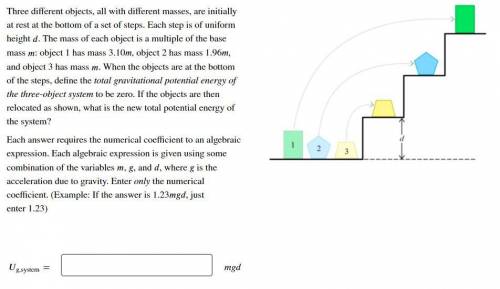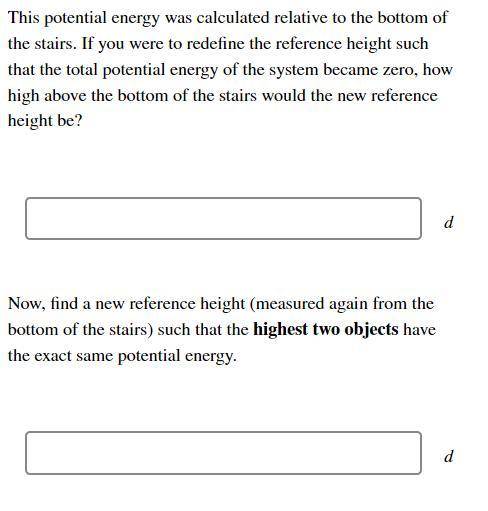
Physics, 04.02.2022 01:00 olivernolasco23
Three different objects, all with different masses, are initially at rest at the bottom of a set of steps. Each step is of uniform height . The mass of each object is a multiple of the base mass : object 1 has mass 3.10 , object 2 has mass 1.96 , and object 3 has mass . When the objects are at the bottom of the steps, define the total gravitational potential energy of the three-object system to be zero. If the objects are then relocated as shown, what is the new total potential energy of the system?
Each answer requires the numerical coefficient to an algebraic expression. Each algebraic expression is given using some combination of the variables , , and , where is the acceleration due to gravity. Enter only the numerical coefficient. (Example: If the answer is 1.23 , just enter 1.23)
This potential energy was calculated relative to the bottom of the stairs. If you were to redefine the reference height such that the total potential energy of the system became zero, how high above the bottom of the stairs would the new reference height be?
Now, find a new reference height (measured again from the bottom of the stairs) such that the highest two objects have the exact same potential energy.



Answers: 3


Another question on Physics

Physics, 22.06.2019 07:20
If 2 moles of co_2 at 2l and 500k are expanded reversibly to 20l, more work can be obtained from an adiabatic process than from an isothermal process. is the above statement true or false?
Answers: 3

Physics, 22.06.2019 10:00
One object has a mass of 1 kg and another object has a mass of 3 kg. if the speeds are the same, which of the following is true about their kinetic energy?
Answers: 2

Physics, 22.06.2019 10:40
Two point charges are on the y axis. a 3.90-µc charge is located at y = 1.25 cm, and a -2.4-µc charge is located at y = −1.80 cm. (a) find the total electric potential at the origin. v (b) find the total electric potential at the point whose coordinates are (1.50 cm, 0). v
Answers: 1

Physics, 22.06.2019 14:40
Asolid cylinder and a cylindrical shell have the same mass, same radius, and turn on frictionless, horizontal axles. the cylindrical shell has light-weight spokes connecting the shell to the axle. a rope is wrapped around each cylinder and tied to blocks of equal masses that are held the same height above the ground. both blocks are released simultaneously. the ropes do not slip. which block hits the ground first? or is it a tie?
Answers: 3
You know the right answer?
Three different objects, all with different masses, are initially at rest at the bottom of a set of...
Questions


Mathematics, 20.04.2021 02:10



Mathematics, 20.04.2021 02:10

English, 20.04.2021 02:10


Mathematics, 20.04.2021 02:10



Mathematics, 20.04.2021 02:10






English, 20.04.2021 02:10


History, 20.04.2021 02:10



